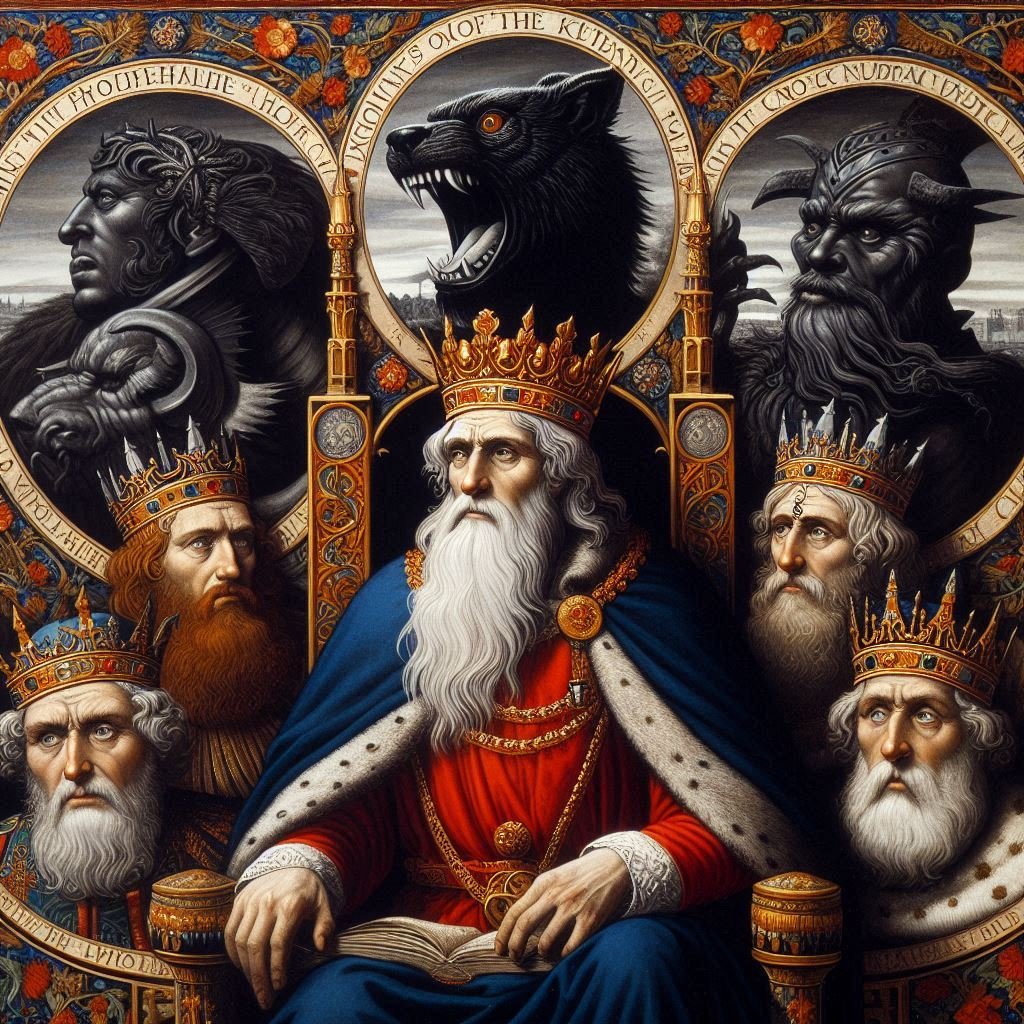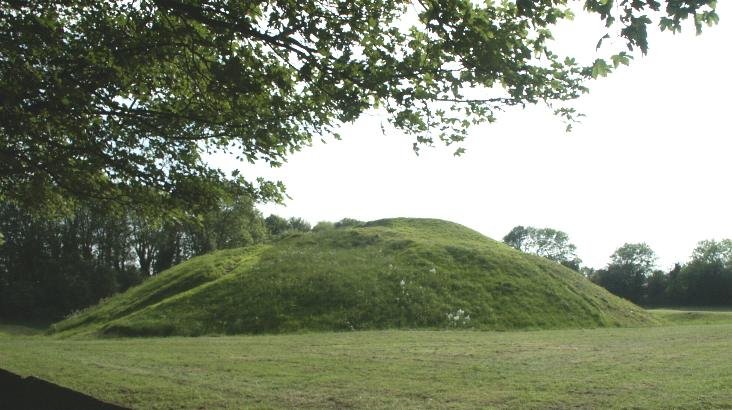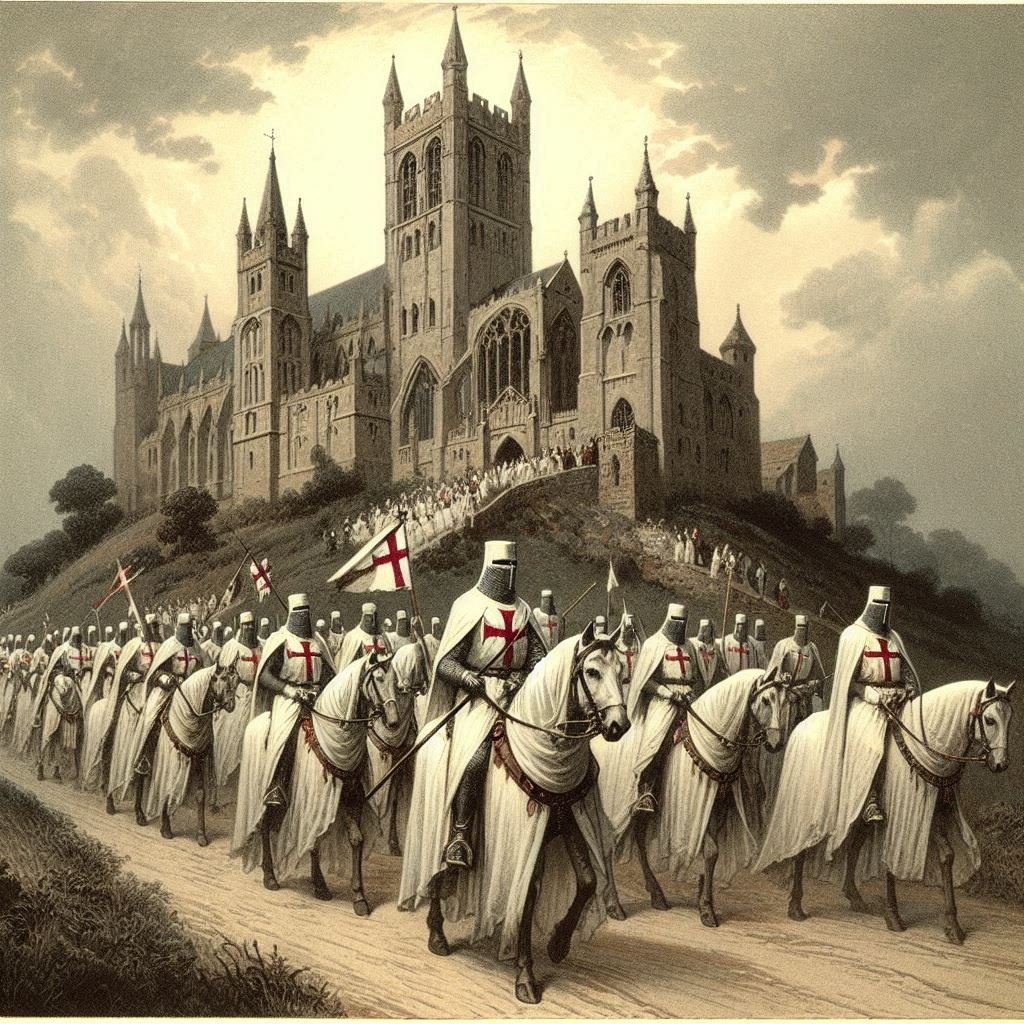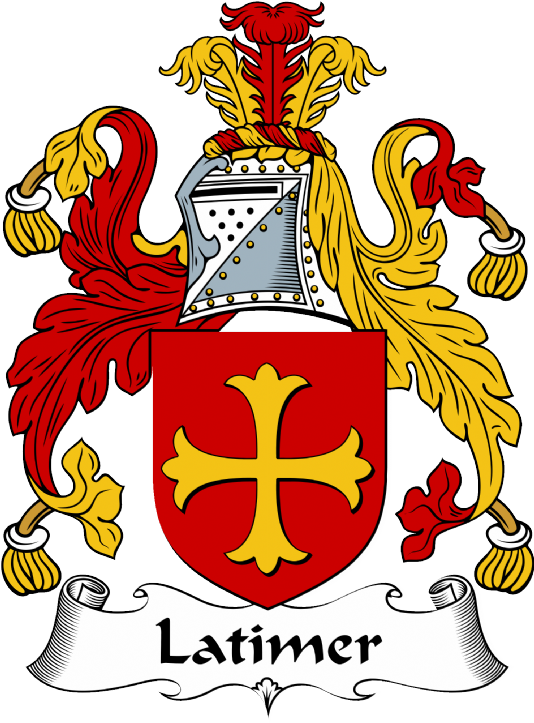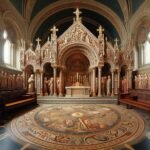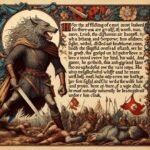
The Knights Templar, an order of warrior monks founded in the 12th century, had a significant presence in Yorkshire, England. They were known as formidable fighters during the Crusades and were recognized by their distinctive white mantles with a red cross.
The Templars were also renowned for their strict code of conduct and their role in protecting pilgrims travelling to the Holy Land. In Yorkshire, the Templars established several preceptories, which were centres for administration and farming, generating revenue to support their activities in the Holy Land. These preceptories included notable sites such as Temple Newsam and Ribston and Penhill Preceptory in the Yorkshire Dales. The Templars’ influence in Yorkshire grew so substantial that they acquired vast tracts of land and established a network of these preceptories across the region.
The Templars’ fortunes, however, took a dramatic turn in the early 14th century. Accusations of heresy and corruption, likely spurred by the envy of their wealth and power, led to the order’s downfall. King Philip IV of France, deeply indebted to the Templars, took advantage of these rumours to launch a campaign against them, which quickly spread to other European monarchies, including England.
In Yorkshire, the Templars were arrested, and their properties were seized. The trials that followed were a mix of fact and fiction, often based on coerced confessions. Despite the lack of concrete evidence, the order was disbanded, and their assets were transferred to the Knights Hospitaller, another military order.
The legacy of the Knights Templar in Yorkshire is still evident today. The names of places like Temple Newsam and the remains of the preceptories serve as reminders of their once formidable presence. The Templars’ story in Yorkshire is a microcosm of their broader history: a tale of faith, valour, wealth, and ultimately, tragedy. Their impact on the region’s history is indelible, leaving behind a narrative that continues to fascinate historians and enthusiasts alike.
The accusations of heresy against the Knights Templar were both varied and severe, marking one of the most dramatic episodes in the history of the medieval church. In 1307, King Philip IV of France, driven by a desire to extinguish his debts and seize the Templars’ wealth, launched a campaign of arrests and charges against the order. The Templars were accused of numerous offences, including the denial of Christ, spitting on the cross during initiation ceremonies, and worshipping idols, which supposedly included a figure known as Baphomet. Other charges were of a more scandalous nature, such as engaging in homosexual practices and financial corruption.
The trials were marked by extreme measures, with many Templars subjected to torture to extract confessions. Under duress, some members admitted to these charges, although later, many retracted their confessions, stating they were made under the pressure of torture. The most prominent of the accused was Jacques de Molay, the Grand Master of the Knights Templar, who initially confessed to the charges but later recanted. Despite the dubious nature of the confessions and the lack of concrete evidence, the scandal culminated in the dissolution of the order by Pope Clement V in 1312.
The Templars’ trial was not uniform across Europe; in some regions, they were found innocent, while in others, like France, they faced severe punishment. The Chinon Parchment, discovered in the Vatican Secret Archives in the early 21st century, revealed that Pope Clement V had absolved the last leaders of the Templars of heresy, though this did not become widely known until centuries later. The document suggested that the pope was more sympathetic to the Templars than previously thought, but he was under immense pressure from King Philip IV.
The downfall of the Knights Templar is a complex tale of power, greed, and the manipulation of the judicial process. It serves as a stark reminder of how accusations, especially those as grave as heresy, can be used as tools in political and financial machinations. The Templars’ story has left an indelible mark on history, and the mystery surrounding their supposed heresies continues to intrigue scholars and the public alike.
Baphomet
The figure of Baphomet played a central role in the accusations against the Knights Templar, serving as a focal point for the charges of heresy that ultimately led to the order’s downfall. The name Baphomet is thought to have first emerged during the Crusades, possibly as a corruption of “Mahomet,” an old French term for Muhammad, the founder of Islam. This association with Islam was likely used to paint the Templars as traitors to Christianity, suggesting they had forsaken their faith to worship a Muslim figure or idol.
During the trials of the Templars, which began in 1307, many Templars confessed under torture to worshipping an idol named Baphomet, among other heretical practices. These confessions, however, are widely considered to be unreliable due to the extreme duress under which they were obtained. The descriptions of Baphomet varied wildly, with some accounts describing it as a severed head, others as a cat, and still others as a figure with three faces or with the body of a goat.
The ambiguity surrounding Baphomet has led to numerous interpretations over the centuries. Some scholars suggest that the Templars might have been involved in Gnostic practices, venerating knowledge and wisdom above the orthodox teachings of the Church, and that Baphomet was a symbol of this secret knowledge. Others propose that the Templars were engaged in a form of psychological training, preparing members for the possibility of capture and forced renunciation of their faith by simulating such conditions.
In the 19th century, the figure of Baphomet became intertwined with occultism, particularly through the work of Eliphas Levi, who depicted Baphomet as a winged humanoid goat with a torch between its horns, symbolizing enlightenment. This image has since become iconic, representing the duality of existence and the balance of opposites, far removed from the original accusations levelled against the Templars.
The true nature of Baphomet and its role in the Templar Order remains one of history’s enduring mysteries. The lack of concrete evidence and the fantastical nature of the confessions have led many to conclude that the charges were part of a smear campaign orchestrated by King Philip IV of France to discredit the Templars and seize their considerable wealth. The myth of Baphomet has evolved, reflecting the changing perspectives on the Templars and their legacy.

Symbology of the Knights Templar
The Knights Templar were associated with various symbols that held significant meaning within the order and became emblematic of their identity. The most iconic of these is the red cross, which adorned their white mantles and represented their commitment to Christian ideals and their role as protectors of Christian pilgrims. Another important symbol was the Beauceant, the battle flag of the Templars, which was bifurcated into black and white sections, symbolizing the Templars’ dual nature as monks and warriors.
Other symbols associated with the Templars include the Agnus Dei, or Lamb of God, which signified their religious devotion and purity. The image of two knights upon a single horse was another emblem, reflecting the Templars’ vows of poverty and the brotherhood among the knights. This image was also indicative of the order’s early poverty, suggesting that they had only one horse for every two knights.
Lesser-known symbols used by the Templars included the star, which may have represented the celestial guidance they sought in their travels and battles. The dove was another symbol, often representing the Holy Spirit and peace, which was an ideal the Templars were sworn to uphold despite their martial activities. The lion, a common heraldic symbol, denoted bravery and strength, virtues highly esteemed by the Templars.
The Templars also used various crosses in their iconography, such as the patty cross and the cross pattée, which appeared on their seals and on the attire of the knights. The fleur-de-lis, a symbol commonly associated with French royalty, was also adopted by the Templars, reflecting their origins in the region and their close ties with the French monarchy.
In addition to these, Templar graves have been found engraved with swords, signifying the knightly status of the interred, and the cavalry cross, which was a variation of the cross pattée with flared arms, symbolizing their role as mounted warriors. These symbols collectively contributed to the distinct visual identity of the Templars and served as a means of expressing their religious fervour, military mission, and communal ethos.
The Knights Templar, renowned for their military prowess and religious fervour, are also often associated with the use of secret symbols and codes. These served various purposes, from identifying members and safeguarding their communications to protecting their wealth and knowledge. The secrecy surrounding the Templars has led to much speculation and intrigue over the centuries, with many theories positing that they possessed hidden knowledge and used cryptic means to transmit it.
One of the most well-known symbols associated with the Templars is the “Seal of the Templars,” which depicted two knights on a single horse, symbolizing their vows of poverty and brotherhood. This seal was used to authenticate documents and communicate the order’s legitimacy and authority. Other symbols, such as the “Beauceant,” their battle flag, were used to rally the knights in combat and served as a recognizable emblem of their presence on the battlefield.
The Templars were also rumoured to use a complex system of codes and ciphers to protect their correspondence. This would have been especially important given the vast network of outposts and the sensitive nature of their operations. While concrete evidence of specific codes remains elusive, the Templars’ banking operations, which involved transferring large sums of money across Europe and the Holy Land, likely required some form of secure communication to prevent theft and ensure the privacy of their transactions.
In addition to symbols and codes, the Templars are said to have employed various architectural and artistic motifs in the construction of their buildings and churches. Some researchers suggest that these designs contained encoded information about the order’s practices and beliefs.
Their buildings and churches often exhibit a fusion of Romanesque and Gothic styles, reflecting the order’s innovative spirit and the transition between these two significant architectural periods. Romanesque architecture, characterized by its robustness and simplicity, featured rounded arches and thick walls, symbolizing strength and endurance. The Templars’ early constructions embraced this style, with the rounded arches perhaps representing the eternal nature of their religious devotion.
As the architectural tastes evolved, the Templars adopted the Gothic style, which allowed for higher ceilings, pointed arches, and large stained-glass windows that bathed the interiors in light, symbolizing spiritual aspiration. The use of light was particularly significant, as it could represent the divine light of God, illuminating the path to salvation. The Templar churches often contained intricate carvings and geometric patterns, which some researchers believe held encoded information about the order’s secretive practices and beliefs. For instance, the use of the equilateral cross, which could be interpreted as a symbol of balance and equality, reflecting the Templar’s desire for a just and orderly society.
Moreover, the Templars were known for their fortress-like castles and intricately adorned cathedrals, which bore the unmistakable stamp of Templar influence. Their mastery of both Romanesque and Gothic styles left an indelible mark on numerous structures across Europe. The evolution of Templar architecture holds a significant place in architectural history, shaping the transition from Romanesque to Gothic styles. Templar symbolism can be observed in the use of intricate carvings, stained-glass representations, and geometric patterns. These elements conveyed their religious beliefs and sacred narratives, evoking a sense of reverence within the spaces they built.
In addition to their architectural contributions, the Templars’ artistic motifs extended to their shields, which often featured the red Cross pattée on a white field, along with various intricate patterns and motifs. These designs were not only a testament to the knights’ artistic prowess but also to their spiritual devotion, as the shields served both a practical purpose in battle and a symbolic one in representing their identity and faith.
The Templars’ architectural and artistic legacy continues to inspire awe and reverence, with their constructions standing as a testament to their enduring legacy. Their ability to draw on the building practices of different nation-states and to learn from both adversaries and friends in the Levant allowed them to create massive structures that could withstand heavy bombardment. This adaptability and practicality in their architectural endeavours are often understated but remain a crucial aspect of their historical narrative. The Templars’ influence on medieval architecture and artistry is a fascinating blend of practicality, spirituality, and mystery, which continues to captivate researchers and enthusiasts to this day.
The Holy Grail and the Ark of the Covenant
The mystery of the Templars’ secret knowledge was further fuelled by their association with legendary artifacts such as the Holy Grail and the Ark of the Covenant. It is speculated that if they did possess such relics, they would have created elaborate codes to hide their locations. The Templars’ downfall and the subsequent dispersion of their members have led to endless speculation about whether any such treasures were hidden and, if so, where they might be found.
The fascination with Templar symbols and codes has persisted into modern times, inspiring numerous works of fiction and conspiracy theories. The popular novel “The Da Vinci Code” by Dan Brown, for example, explores the idea of the Templars guarding secret knowledge about the lineage of Jesus Christ. While such stories are fictional, they reflect the enduring allure of the Templars’ supposed secret symbols and codes.
The banking system of the Templars
The Knights Templar were not only fierce warriors of the Crusades but also pioneers in the development of early banking systems, which laid the groundwork for modern financial practices. Their banking operations emerged out of necessity, as the Templars sought to provide secure financial services to pilgrims travelling to the Holy Land. Recognizing the dangers pilgrims faced in carrying valuables over long distances, the Templars offered a revolutionary solution: depositing funds at a Templar house in their home country and withdrawing the equivalent amount upon reaching their destination. This system protected pilgrims from theft and loss, effectively functioning as an early form of traveller’s checks.
The Templars’ banking network was extensive, with branches across Europe and the Middle East, facilitating not only the safekeeping of assets but also the provision of loans, particularly to monarchs and nobles. Their ability to mobilize large sums of money quickly made them indispensable in financing crusades and other ventures, bolstering their influence and power significantly. The Templars issued letters of credit, an innovative practice at the time, which allowed for the transfer of funds without the actual movement of coinage, reducing the risk of theft and loss.
Their financial acumen extended to the management of vast economic resources, including lands, farms, vineyards, mills, and even entire townships. The revenue from these assets further fuelled the Templars’ banking operations, enabling them to engage in complex financial transactions and investments. The Templars’ banking practices were characterized by sophisticated methods of fund management, detailed record-keeping, and an international presence, which together formed the backbone of their financial empire.
However, the Templars’ success in banking also attracted scrutiny and envy. Accusations of corruption and secrecy surrounded their financial dealings, contributing to the aura of mystery that still envelops the order today. Their downfall in the early 14th century, under charges of heresy and other alleged crimes, brought an end to their banking operations. Yet, the legacy of their financial innovations lived on, influencing the evolution of banking and finance long after the order itself had been disbanded.
The Templars’ banking system was a testament to their forward-thinking approach to finance and their ability to adapt to the needs of the time. It was a system built on trust, security, and the efficient movement of funds, principles that remain at the core of banking today. The dissolution of the Templars’ order did not erase the impact they had on the financial world; rather, it highlighted the transformative role they played in shaping the economic landscape of medieval Europe.



